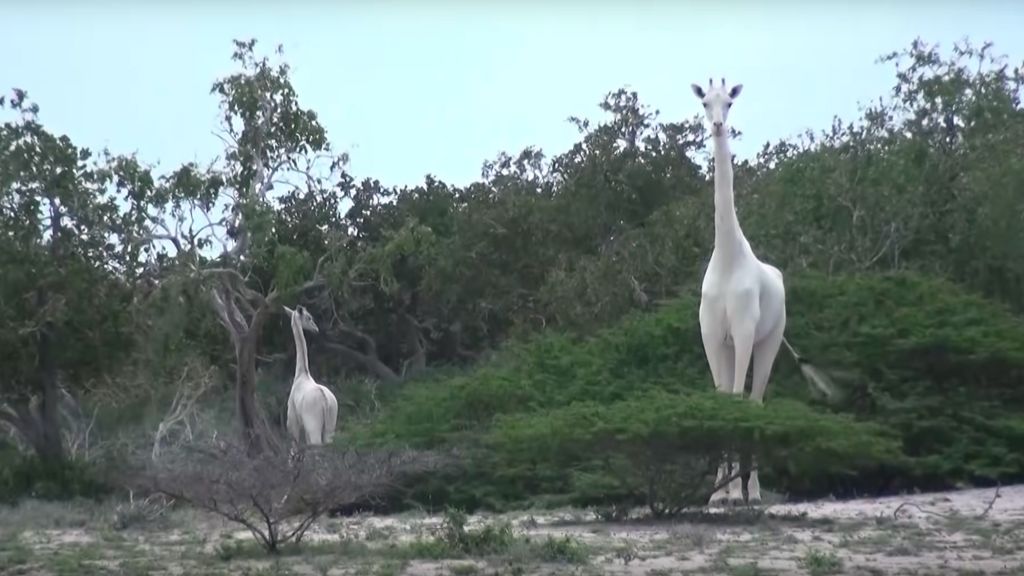Last Known Female White Giraffe Found Dead, Presumed Killed by Poachers

White Giraffe: The skeletal remains of a pair of rare white reticulated giraffes that had been missing for several months were found dead by rangers at a nature conservancy in Garissa County in Kenya.
The two giraffes were a female and her seven-month-old male offspring, and were two of the three white giraffes in the area. The remains looked as though they had been there for about four months, and they appeared to have been killed and butchered by poachers.
The manager of the Hirola Community Conservancy, Mohammed Ahmednoor, called it a very sad event, since the conservancy was the only place to have the rare white animals.
As yet, it isn’t known who the poachers were or what their motives were in killing these particular animals. The conservancy still has one more of the white giraffes, but it is a male.
The white giraffes caught global attention in 2017, when the female was seen grazing, accompanied by a calf who, although not yet white, was very pale, according to the New York Times.
The pair were first spotted by a Kenyan villager who was out herding animals.
At the time, the pair was seen with a third giraffe, who had typical coloring, allowing the conservationists who came to the area in hopes of filming the unusual animals to get a clear baseline comparison of the color differences.
Last year, the female had another white calf, bringing the number of white giraffes at the conservancy to three. The group was a big draw, with visitors coming to the nature preserve in hopes of seeing them.
YouTube videos showing the animals was viewed over a million times, and many news outlets, both in print and video, have also featured them in the intervening years.
SAD NEWS😢: @IshaqbiniHirola Community Conservancy, Garissa County loses two famous white giraffes to poachers.
For more info, here’s the press release. @KWS @USAIDKenya @EUinKenya @denmarkinkenya @Nature_Africa @KWCAKenya @africa_ci @SwedeninKE pic.twitter.com/Nwp1F0VexF
— @nrt_kenya (@NRT_Kenya) March 10, 2020
The family group aren’t albinos, but instead have a genetic condition called leucism, which causes the animals who have the condition to lose some of their pigmentation, although they may keep pigmentation in their soft tissue.
That was the case with the giraffes, who despite their white hides, still had dark eyes and dark hair on the ends of their tails.
Albino have a condition which does not allow them to produce melanin anywhere in their bodies, giving them characteristic red eyes along with the lack of coloring in skin or hair.
Leucism can occur in many mammals, but it is very rare in giraffes. Aside from the family group in Kenya, the only other white giraffe of this type that has been seen was in Tanzania, at the Tarangire national Park, but it hasn’t been seen by anyone since the beginning of 2016.
However, white or not, the reticulated giraffe is considered endangered. The Giraffe Conservation Foundation has estimated that the number of reticulated giraffes in the world has declined by about 56% during the last thirty years, to about 15,780 as of 2018.
There are currently around 111,000 giraffes in Africa, but about half the calves fail to survive their first year, according to the foundation.
The primary reasons for the decline in the population have been identified as loss of habitat due to land clearing and development, and poaching.
Conservation efforts in Kenya and elsewhere in Africa have stepped up, with places like the Hirola conservancy working to preserve populations of animals such as the giraffes and other wildlife which promote tourism and bring much-needed revenues to the country.
Creatures such as rhinos and elephants are also in trouble, as the demand for their ivory horns or tusks is high, either for luxury items or for use in traditional medicines.
Nigel The Parrot, Missing for 4 Years Returns Speaking Spanish
Ahmednoor says that the deaths of the white giraffes will probably have an adverse effect on local tourism, as well as denying an opportunity to geneticists who are interested in the information they could have gained through studying the animals.
